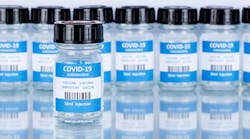Download this article in PDF format.
With the world in the midst of a massive COVID-19 vaccine rollout, and with the effort expected to gain more momentum over the coming months, the pharma supply chain is being asked to flex and adapt in this unprecedented environment. From the manufacturers that are producing the vaccines to the distributors that are managing the logistics to the carriers that are transporting the injections to their final destinations, all links in the supply chain are under extreme pressure to perform right now.
This is a whole new world for many pharma supply chain operators. “Prior to COVID, the pharma supply chain wasn't really exposed to the non-logistics/pharma world,” Trimble Transportation’s Chris Orban told Supply & Demand Chain Executive.
“Drugs were produced, got to their final destination and distributed. A major product launch was still a big deal, and carriers had protocols and security requirements to follow, but it didn't receive the sort of scrutiny that has appeared during COVID-19,” Orban continued. “As with many other areas of our world, COVID-19 has shown both the vulnerability of our way of life, and the power of our supply chain to succeed and deliver when it could have failed.”
Globalization Creates New Complexities
Similar to what’s happened in many other industries, the ongoing globalization of the pharma supply chain has introduced new complexities during the vaccine rollout. Much like automakers work with suppliers from around the globe and wholesale distributors sell to international client bases, the “flattening out” of the world presents new challenges for all companies participating in the supply chain.
“Over the past two decades, pharma supply chains have steadily become more globalized,” Susan Beardslee of ABI Research told S&DCE. “Various steps of the drug manufacturing and distribution process occur in different parts of the world, for example, a medicinal crop might be farmed and harvested in Australia, processed in India, combined with other ingredients to form a final drug at a plant in Germany, and distributed to hospitals or pharmacies in the United States.”
Projects on the scale of the COVID-19 vaccine present even more challenges. As Maria Elena Bottazzi of the Baylor College of Medicine put it, “It’s not like adding more water to the soup.” Globalizing vaccine production means finding sources for every necessary component and scaling up those sources. One production run of the Pfizer vaccine takes anywhere from 60-110 days and the company can make between 1 and 3 million doses of vaccine per run. For each run to be successful, Pfizer is relying on a variety of suppliers to provide them with all the materials they need, from MECO’s 25 million gallons of pharmaceutical-grade water a day to all the delicate ingredients needed to manufacture the vaccine itself. The process is similar for the other mRNA vaccines but might change for those that use attenuated virus particles or other means to trigger the body’s immune response.
Not a Big Surprise
The current vaccine distribution challenges and their impacts on the supply chain should come as no surprise to anyone familiar with how those networks operate. The effort as a whole is completely unprecedented for modern times, and several logistics experts were openly discussing the potential pitfalls in 2020, before the vaccination effort officially rolled out.
In November, IDC’s Simon Ellis talked to FreightWaves about how the strict storage and transportation requirements for the shots were already raising concerns across several U.S. states. “Be mindful that the storage and transportation requirements for at least two of the vaccine candidates require that they be kept at −75°,” Ellis said, “something that the current supply chain is not equipped to handle at scale.”
Other key concerns at the time included the vaccine’s packaging requirements and the delicate orchestration of glass vials, active ingredients and injectables across the supply chain. Because delays in transit can potentially impact COVID-19 vaccine quality, the pharma cold chain had to quickly figure out ways to move large quantities, break them down into smaller shipments and get them to their destinations as quickly as possible using methods like cross-docking (whereby the shipments are unloaded from a truck or railroad car, sorted and directly reloaded onto outbound trucks or rail cars to continue their journey).
Smoother Seas Ahead?
According to Rafael Lander, a principal at PwC, the timeframe for a complete, worldwide rollout of the COVID-19 vaccine could span anywhere from 1-2 years. During that time, expect to see manufacturers, distributors, carriers and logistics providers all sharpening their distribution skills and honing their individual responsibilities. As this occurs, the ongoing COVID-19 vaccination effort and any similar efforts in the future could both go more smoothly.
“The healthcare industry across the globe is trying to vaccinate 7 billion people. Most of the vaccines take two doses per person, so up to 14 billion doses will need to be distributed and manufactured,” Lander pointed out. “This will take time, and with that there is likely to continue to be a strain across the supply chain.”










